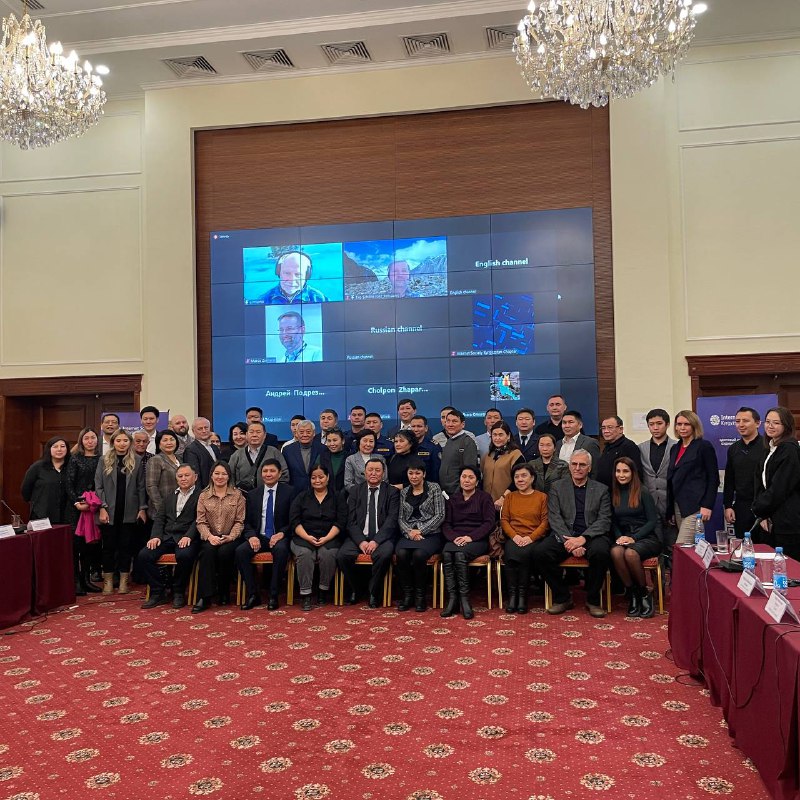Forum Explores Innovative Technologies for Climate Change Monitoring and Disaster consequences Mitigation
Bishkek, December 12, 2022 – Addressing the critical need to safeguard lives and property from climate-related disasters, a high-profile forum titled “Application of Innovative Technologies in Monitoring and Forecasting of Climate Change and Natural Disasters” was successfully held in Bishkek city. The event brought together about 100 local and international experts, government representatives, policymakers, and stakeholders to discuss groundbreaking information and communication technologies for sustainable development in the face of alarming climate change predictions.
Mr. Shaazadan Tyumonbaev, Deputy Head of the Monitoring and Analysis Department of the Presidential Administration of the Kyrgyz Republic, commenced forum with thought-provoking introduction highlighting the urgent task of mitigating climate change and its impact on sustainable development of the Kyrgyz Republic.In response, experts, scientists and policymakers emphasized the importance of embracing affordable technologies for climate change mitigation.
Mr. Bolot Moldobekov, co-director of the Central Asian Institute of Applied Geosciences, made presentation titled “Hazardous natural processes and monitoring systems” that highlighted the efforts and initiatives taken by the country to mitigate the impacts of natural disasters. Kyrgyzstan, a geographically vulnerable region, faces numerous hazards such as earthquakes, landslides, floods, mudflows and avalanches. The presentation discusses the existing monitoring infrastructure, observed geographic areas, specific sensors installed in locations and insights from data observations.
Talant Sultanov, chair and co-founder of the Internet Society Kyrgyz Chapter, in his presentation “ICT for disaster resilience” marked how bottom-up initiatives in the example of ISOC Kyrgyz Chapter helped to prevail internet connectivity challenges for landlocked or sanctions-locked countries such as Kyrgyzstan.
The event emphasized the role of observation, research, and forecasting in disaster prevention, underscoring the significance of data gathered from various monitoring stations. Among the array of innovative technologies discussed, one particular standout was LoRaWAN (Long Range Wide Area Network) data transfer technology for the Internet of Things (IoT). This technology enables “smart” sensors to monitor indicators in real-time, analyze the data, and transmit it to servers for further processing.
An impressive feature of LoRaWAN technology is its ability to operate wirelessly and autonomously for up to 10 years without a power supply, making it an ideal solution for climate monitoring stations in remote or challenging terrains. The absence of wiring simplifies the implementation process, while remaining cost-effective for widespread adoption. Ermanno Pietrocemolli, expert from the Abdus Salam International Center of Theoretical Physics made thorough presentation about Lorawan technology for various purposes. Marco Zennaro on behalf of ICTP demonstrated past installs of lorawan sensors and how ICTP team transmitted data using traditional unlicensed spectrum for up to 400km.
Distinguished speakers from governmental departments, research institutions, and industry shared valuable insights during the forum. Presentations covered a wide range of topics, including climate change monitoring, the CAIAG (Central Asian Institute for Applied Geosciences) monitoring system, and the creation of a secure IoT infrastructure using LoRaWAN technology for emergency prevention in mountainous areas of Kyrgyzstan.
Participants had the opportunity to engage in lively discussions and pose questions to the experts during dedicated Q&A sessions. Topics such as wireless technologies for IoT and the pros and cons of LoRaWAN technology were thoroughly explored, shedding light on the immense potential and practical considerations of these emerging solutions.
The forum concluded with a comprehensive summary and concluding remarks, emphasizing the crucial role of innovative technologies in monitoring and preventing natural disasters. Participants left with a renewed commitment to harness the power of technology for sustainable development and climate resilience. By the request of the Ministry of Emergency Situations, two locations in Boom gorge had been added to the list of pilot locations where automatic meteo stations and sensors should be installed.
The “Application of Innovative Technologies in Monitoring and Forecasting of Climate Change and Natural Disasters” forum served as a catalyst for knowledge exchange, collaboration, and the advancement of effective strategies to combat climate change and protect lives and property. By embracing cutting-edge technologies like LoRaWAN, the global community can forge a path towards a safer, more sustainable future.
For more information about the forum and its outcomes, please visit https://isoc.kg or contact Aziz Soltobaev, Projects Coordinator, [email protected]
Press Contact: Talant Sultanov, Chair of the Internet Society Kyrgyz Chapter, [email protected]


